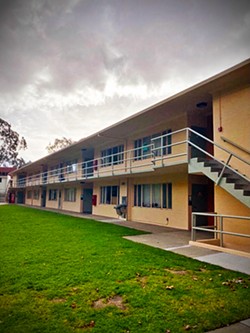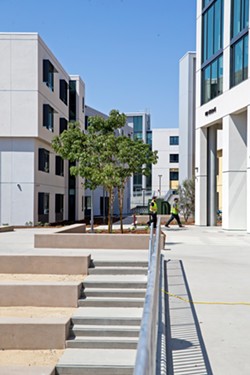Feeling separated: Scholarship students push back against Cal Poly's on-campus housing policies
By Bulbul Rajagopal[{
"name": "Ad - Medium Rectangle CC01 - 300x250",
"id": "AdMediumRectangleCC01300x250",
"class": "inlineCenter",
"insertPoint": "8",
"component": "2963441",
"requiredCountToDisplay": "12"
},{
"name": "Ad - Medium Rectangle LC01 - 300x250",
"id": "AdMediumRectangleCC01300x250",
"class": "inlineCenter",
"insertPoint": "18",
"component": "2963441",
"requiredCountToDisplay": "22"
},{
"name": "Ad - Medium Rectangle LC09 - 300x250",
"id": "AdMediumRectangleLC09300x250",
"class": "inlineCenter",
"insertPoint": "28",
"component": "3252660",
"requiredCountToDisplay": "32"
}]
It was only when her mother used the bathroom on move-in day that Cal Poly first-year student Cassandra Garcia realized her new residence hall might have an overcrowding problem.
"She looked around and said, 'You guys have only two stalls, two everything. Are you gonna be OK living like this?' I said, 'Yeah, we'll make it work,'" Garcia said.
But Garcia quickly found out that living in the North Mountain Residence Hall required more than just the old college try of sharing community spaces with a few peers. During September 2021, the San Bernardino native discovered that the two-story dorm building brimmed with 90 students including RAs.
Each of the two floors has four bathrooms, split evenly between men and women. This meant that she shared the cramped two-shower, two-sink, two-toilet bathroom with 11 girls on her floor.
"We [don't] have a community center or a study hall. We just have the basics of a room, three laundromats, and some benches outside to work at if we wanted to," Garcia said.
The University Housing website states that students request placement into residential categories rather than specific buildings when they apply for housing. These structures are called Residential Learning Communities, and they include a variety of housing sections like the Pride community for LGBTQ-plus identifying students and a substance-free community for students who want to live in an environment without tobacco, alcohol, and drugs.
Garcia belongs to the Educational Opportunity Program (EOP), which is geared toward historically and economically disadvantaged students. The invite-only EOP supports its scholars with financial aid to attend Cal Poly, which, at $10,195 for full-time tuition and campus fees for the 2021-22 academic year, is the most expensive in the California State University (CSU) system.
Unlike most students who get to choose the Residential Learning Community they want to be a part of, Garcia said that EOP scholars live together. In the 2021-22 school year, they were placed in North Mountain. Built in 1952, it's the oldest set of dorms at Cal Poly. With three students to a room, Garcia found her North Mountain peers struggling with the cramped living experience, too. She ultimately penned an opinion piece for Mustang News labeling the residential grouping as "modern-day segregation." The piece highlighted Cal Poly's status as the least diverse university in the CSU and University of California collegiate systems. Garcia said that her EOP advisor reached out to her over Zoom after the article was published to listen to constructive criticism.
"A lot of second-year students told me they felt the same way. Last year, during the pandemic, they felt it was a totally different scene because they had to pay extra for only having one person in the dorm because of COVID," she said. "So, instead of 12 people sharing a bathroom, it was only four. They still felt it was mainly people of color living in those dorms."
Garcia said that one of the most coveted residential communities in Cal Poly is
Northern Chumash language. Opened in 2018 and dedicated to honor the university's relationship with the Northern Chumash, the yakʔitʸutʸu dorms are higher-end with facilities like serenity rooms for relaxation. A map of its all-gender bathrooms shows seven shower and toilet stalls, including handicap accessible ones.
In her opinion piece, Garcia wrote that Cal Poly placed majority white and wealthy students in those dorms. She added that since the yakʔitʸutʸu dorms are supposed to respect Native American relations, the university should populate them with minority students receiving financial aid.
Matt Lazier, Cal Poly's media relations director, told New Times that university housing officials consult with campus partners annually about the locations of Residential Learning Communities. Financial-support programs like the EOP "consistently requested" Residential Learning Communities (RLCs) with a lower-cost option.
"It is important to reiterate the point that student residents and program administrators are involved in choosing the locations of RLCs each year. Given this, University Housing is always open to feedback—both positive and constructive critical input—from its program participants, and this information is considered in the broader discussion of where RLCs will be located from one year to the next," Lazier said.
According to Cal Poly's University Housing cost breakdown, a double room in a residential hall is almost $1,000 cheaper than the same in yakʔitʸutʸu in the 2021-2022 academic year. Double rooms in yakʔitʸutʸu are also almost $1,450 more expensive than triple rooms in other university dorms.
But several students living in North Mountain feel that campus officials don't respond to their call for help. Ithzel Castaneda is a Cal Poly first-year who lives on the floor above Garcia's in Lassen Hall—one of the five buildings that makes up the North Mountain block. She's part of a throng of Cal Poly students who agreed with Garcia's piece.
"The rooms are really cold, there's no heat. The windows are really old, and they don't work. You don't get to meet other people outside EOP scholars around that area, which is sad," Castaneda said.
She mentioned that North Mountain is cut off from campus dining facilities, which becomes a problem when it's time for dinner. Castaneda said the seven-minute walk from her dorm to the Vista Grande Cafe is worrisome at night when the campus is emptier. Oftentimes, she feels safer resorting to the Starbucks at University Union near North Mountain at the cost of a more wholesome meal. The yakitutu dorms, however, are right across from Vista Grande, only two minutes away.
Castaneda said one of the showerheads in the bathroom on her floor has been defunct since September. So, roughly a dozen students shared one shower stall until winter break.
"We tried to fix it ourselves but there's not much to do about it," she said. "Us students that are in EOP, we've noticed the difference in location. We're put off to the side compared to the other students. I would agree it's modern segregation."
Garcia added that the housing department takes a long time to fix issues when complaints are filed through the student portal.
"I know that my neighbor asked housing if they can lower the bunk bed for him since it was too close to the ceiling, and I think it took three weeks to a month for housing to go and finally lower his bed," she said.
University Housing said that maintenance requests are processed by three levels of priority.
"Lowering bunks is a common request at move-in, a time when there is a higher volume of maintenance requests overall. Roommates must agree to this particular request," housing officials stated. "Although this is a lower priority item as compared to leaks, flooding, water/power outages, etc., we can generally get to them in a timely manner, once high-priority requests are cleared."
Castaneda and her two roommates haven't alerted the maintenance department about the housing issues yet, but she said they're running low on hope.
"We all feel like an afterthought. I feel like Cal Poly tries to say they help students of color. There is help, but not enough of it. Small things like a simple showerhead, we're even hesitant to ask for help about that," she said. Δ
Reach Staff Writer Bulbul Rajagopal at [email protected].
Latest in News
Comments (3)
Showing 1-3 of 3
Readers also liked…
-

Coast Unified teachers upset over new position's salary and qualifications
Oct 20, 2022 -

SLO police identify alleged driver who hit and killed couple
Dec 22, 2022 -

When the levee breaks: Oceano residents, county officials walk a tightrope of regulations to manage Arroyo Grande Creek, which some say led to the levee's failure in January
May 18, 2023











